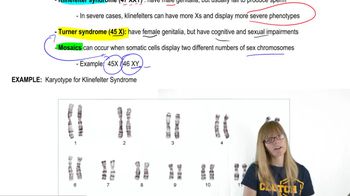Table of contents
- 1. Introduction to Genetics51m
- 2. Mendel's Laws of Inheritance3h 37m
- 3. Extensions to Mendelian Inheritance2h 41m
- 4. Genetic Mapping and Linkage2h 28m
- 5. Genetics of Bacteria and Viruses1h 21m
- 6. Chromosomal Variation1h 48m
- 7. DNA and Chromosome Structure56m
- 8. DNA Replication1h 10m
- 9. Mitosis and Meiosis1h 34m
- 10. Transcription1h 0m
- 11. Translation58m
- 12. Gene Regulation in Prokaryotes1h 19m
- 13. Gene Regulation in Eukaryotes44m
- 14. Genetic Control of Development44m
- 15. Genomes and Genomics1h 50m
- 16. Transposable Elements47m
- 17. Mutation, Repair, and Recombination1h 6m
- 18. Molecular Genetic Tools19m
- 19. Cancer Genetics29m
- 20. Quantitative Genetics1h 26m
- 21. Population Genetics50m
- 22. Evolutionary Genetics29m
3. Extensions to Mendelian Inheritance
Sex Chromosome
Problem 29a
Textbook Question
A wild-type Drosophila male and female are crossed, producing 324 female progeny and 161 male progeny. All their progeny are wild type.
Propose a genetic hypothesis to explain these data.
 Verified step by step guidance
Verified step by step guidance1
span>Step 1: Understand the genetic background of Drosophila. In Drosophila melanogaster, the wild-type phenotype is typically dominant, and sex determination is based on the X and Y chromosomes.</span
span>Step 2: Consider the sex determination mechanism. In Drosophila, females are XX and males are XY. The presence of two X chromosomes results in a female, while one X and one Y chromosome result in a male.</span
span>Step 3: Analyze the progeny ratio. The progeny consists of 324 females and 161 males, which suggests a deviation from the expected 1:1 sex ratio.</span
span>Step 4: Propose a hypothesis. The deviation from the expected 1:1 ratio could be due to a genetic factor affecting the viability of male progeny, such as a recessive lethal allele on the X chromosome that is masked in females (XX) but expressed in males (XY).</span
span>Step 5: Consider alternative explanations. Other factors, such as environmental influences or genetic linkage, could also contribute to the observed sex ratio, but the presence of a sex-linked lethal allele is a plausible genetic hypothesis.</span
Recommended similar problem, with video answer:
 Verified Solution
Verified SolutionThis video solution was recommended by our tutors as helpful for the problem above
Video duration:
2mPlay a video:
Was this helpful?
Key Concepts
Here are the essential concepts you must grasp in order to answer the question correctly.
Sex-linked Inheritance
In Drosophila, certain traits are often linked to sex chromosomes, particularly the X chromosome. Males have one X and one Y chromosome, while females have two X chromosomes. If a trait is sex-linked, it can exhibit different inheritance patterns in males and females, which is crucial for understanding the progeny ratios observed in the cross.
Recommended video:
Guided course

Sex-Linked Genes
Wild-type Phenotype
The wild-type phenotype refers to the most common or typical form of a trait found in a natural population. In this case, all progeny being wild type suggests that the alleles for the traits being studied are dominant or that the wild-type allele is present in both parents, leading to the expression of the wild-type phenotype in all offspring.
Recommended video:
Guided course

Mutations and Phenotypes
Progeny Ratio Analysis
Analyzing the ratio of male to female progeny can provide insights into the genetic mechanisms at play. In this scenario, the ratio of 324 females to 161 males suggests a potential sex-linked inheritance pattern, as the expected ratio for a typical Mendelian cross would be 1:1 for male and female offspring, indicating that the trait may be influenced by the sex chromosomes.
Recommended video:
Guided course

Chi Square Analysis

 4:24m
4:24mWatch next
Master Sex Determination with a bite sized video explanation from Kylia Goodner
Start learningRelated Videos
Related Practice



